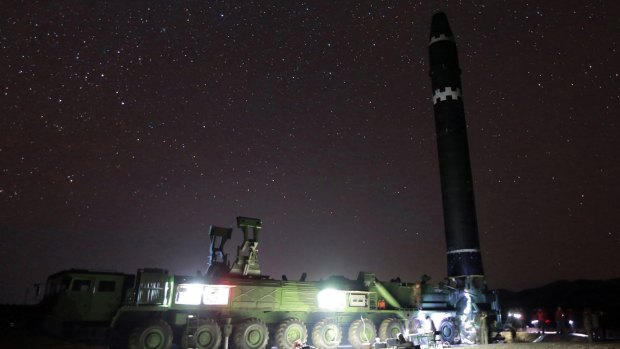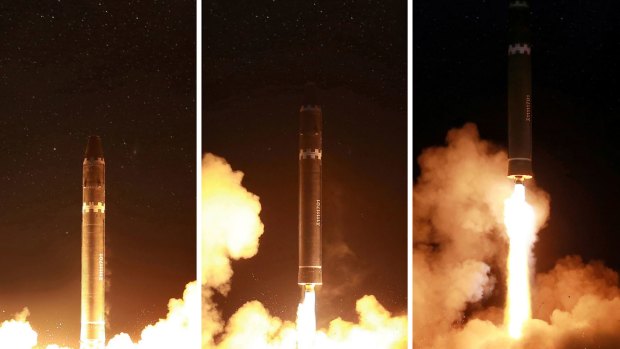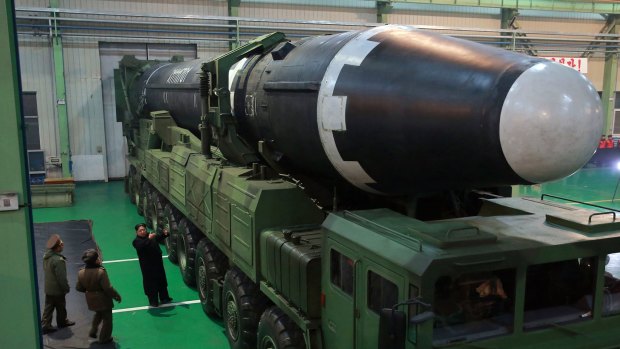This was published 6 years ago
North Korea 'just joined the club': Images of new ballistic missile show it's a monster
By Jane Onyanga-Omara and Anna Fifield
North Korea has released numerous images it says are of the new intercontinental ballistic it launched on Wednesday, claiming it is capable of striking "the whole mainland of the US."
The North's new agency KCNA issued a report stating the Hwasong-15 carried a "super-large heavy warhead." The report said Kim watched the launch and "declared with pride that now we have finally realised the great historic cause of completing the state nuclear force."
State television also ran a special broadcast on the launch, which showed Kim personally signing the launch order.
Although there is still much that can't be gleaned from the photos and North Korea does have an inglorious record of exaggeration, analysts generally agree that the Hwasong-15 marks a significant leap forward in North Korea's missile development.

The North Korean Hwasong-15 intercontinental ballistic missile ready for launch in North Korea. Credit: AP
"This is a really big missile, much larger than I expected," said Scott LaFoy, an imagery analyst for the specialist website NK News. "I believe one of my professors would have referred to it as a big honking missile."
Several analysts noted that the missile looked like the American Titan II, which was initially an ICBM but was then later used by the US Air Force and NASA as a space launch vehicle.
Michael Duitsman, a researcher at the Centre for Nonproliferation Studies in Monterey, California, tweeted soon after the photos were published: "This is very big missile ... And I don't mean 'Big for North Korea.' Only a few countries can produce missiles of this size, and North Korea just joined the club."
Duitsman suggested the new ICBM appears to have a different engine arrangement and improved steering from the the smaller Hwasong-14 ICBM that the North tested twice in July.

The Hwasong-15 intercontinental ballistic missile, in North Korea.Credit: AP
"They wanted [to be able] to hit all of the US and they wanted something big to hit it with. This seems on the surface level to be that missile," David Schmerler, a research associate at the James Martin Centre for Nonproliferation Studies, told CNN.
The Hwasong-15 appears to be the longest-range missile ever tested by North Korea, which said it reached an altitude of 4473km and flew a distance of 949km in 53 minutes.

North Korean leader Kim Jong-un, third from left, and what the North Korean government calls the Hwasong-15 intercontinental ballistic missile, in North Korea. Credit: KCNA/AP
It would have had a range of 13,000km had it flown in a flat trajectory, according to calculations by David Wright, an expert at the Union of Concerned Scientists. That would make it capable of reaching Washington, DC.
President Donald Trump tweeted Wednesday: "Just spoke to President XI Jinping of China concerning the provocative actions of North Korea. Additional major sanctions will be imposed on North Korea today. This situation will be handled!"
Trump later called the North's leader, Kim Jong-un "Little Rocket Man" and "a sick puppy."
Members of the UN Security Council condemned the missile launch at an emergency meeting in New York on Wednesday.
Analysts have gleaned several details from the photographs:
The truck: The transporter erecter launcher, or TEL, has nine axles, making it one axle longer than the TEL used to launch the previous iteration of the intercontinental ballistic missile. North Korea claims to have made these trucks itself but analysts believe they are modified versions or based on the Chinese lumber truck, the WS51200.
"We've seen heavy vehicle extensions before but this would this would be a very large step forward for their heavy vehicles industry," said LaFoy, estimating that the truck was about twice as long as an American school bus. "We know that this is pretty difficult. It took China a while to figure this out."
The nose cone: The nose cone of the Hwasong-15 is much blunter than of the previous iteration, the Hwasong-14. This is likely an effort to slow down the missile slightly as it screams through the atmosphere, which lowers the heat inside the missile and means that the warhead doesn't have to withstand quite as much variation in temperature during flight.
This might be an effort to overcome issues with the re-entry vehicle - the part of the missile that protects the warhead during launch and brings it back into the Earth's atmosphere. This is one of the parts of the missile that North Korea has not yet proven it has mastered.
The size of the nose cone and re-entry vehicle on the Hwasong-15 supports North Korea's claim that the missile can carry a "super large heavy warhead." But experts think the missile tested this week was carrying a light, mock warhead.
The Hwasong-14 and 15 are likely to have carried only very small payloads, which may have exaggerated the range they missile can fly, said Michael Elleman, senior fellow for missile defence at the International Institute for Strategic Studies. Basically, the heavier the warhead, the shorter the distance it can travel.
If the Hwasong-15 was fitted with a half-tonne payload and flown on a standard trajectory, it could probably fly about 8500km, Elleman wrote for 38 North, a website devoted to North Korea, meaning that a 600-kilogram payload "barely reaches Seattle."
Still, with its publication of this huge re-entry vehicle, Kim's regime is clearly signalling that this is their ultimate goal.
Engines: The first stage of the Hwasong-15 - the bottom part that propels it off the launcher, sometimes called the "booster" - has two engines. "We're trying to figure out what those may be and how powerful they are," said David Wright of the Union of Concerned Scientists.
But the second stage looks like it can carry more than twice as much propellant as the Hwasong-14, since it is longer and has a larger diameter, Wright said. "The combination of those two things means it really is a new, more capable missile."
The addition of two engines doubled the second stage thrust and allows the missile to reach a higher peak altitude, Elleman said. This missile reached a height of about 4500km - or ten times as high as the International Space Station.
Steering: The Hwasong-14 had only one nozzle and it used four vernier engines to steer the missile. But the newly unveiled Hwasong-15 has two nozzles and no verniers. That suggests the missile is steered by gimballing, a more advanced way to control the missile.
"This is a sort of maneuvering which is pretty fancy. You lose the least thrust that way," said LaFoy. "We knew they'd get there eventually but we didn't think the North Koreans were there yet."
US President Donald Trump called the North's leader, "Little Rocket Man" and "a sick puppy" after the launch.
MCT, Washington Post